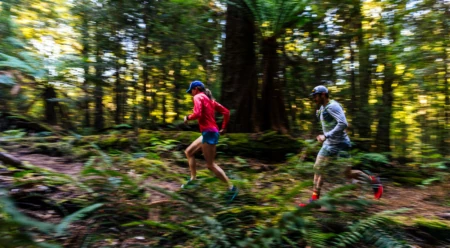If You Love It, Run for It: Dispatch from the Inaugural Takayna Ultramarathon
Krissy Moehl reports from the 2019 inaugural takayna ultramarathon
“There are no footprints.” Fellow Patagonia ambassador and New Zealand native Grant Guise voiced what I was thinking. Our headlamps and phone lights dimly illuminated the overgrown double-track from Rebecca Road. “If 100 people are starting a race in five minutes, we would see footprints,” he said matter-of-factly. Out of cell service, completely jetlagged and not really knowing what time it was after traveling 40 hours with less than 36 to adjust and start the 65 km takayna ultramarathon in Tasmania, Australia, I wondered if we’d misjudged the time. “Are we sure it starts at 6:30 a.m.?”
The evening before, a large group of runners and volunteers had gathered at Marrawah Hall. It was easy to identify the two groups—the runners carried packed hydration packs full of required gear. I lined up with everyone else, but as soon as I spoke, I stood out. “Where are you from?” I’ve never thought of myself as having an accent, but it was clear that I wasn’t from Australia. “America or Canada?” was their response when I asked where they might place me. Hailing from the Pacific Northwest, specifically Bellingham, Washington, I am closer to Vancouver, BC, than to Seattle and apparently that reflects in my speech.
We slowly scooted forward toward the hall entrance, and I saw others leaving with a T-shirt in hand and smiles on their faces. I took in the brick building framed by a large black marquee tent, a couple of banners and three port-a-potties. I noticed the advertising for the race, but it was tastefully done so as not to overrun the gathering. A bubbly Kate Hanson broke my wandering eyes with her direct exclamation, “Thank you for your book! I know who you are. Others might not, but I know you and your book. It has helped me so much!” This far away from home, to be greeted by her energy and smile touched my heart, and we continued to talk as the distance to the brick building entrance decreased. Simon Harris, the fundraising coordinator and my main race contact to this point, smiled warmly and reached across the table of shirts to welcome me in a hug. Grant and I collected our race numbers and tees.
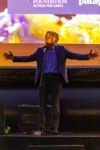
Bob Brown speaking about the great privilege of protecting takayna / Tarkine. Photo: Jarrah Lynch
“Be sure to look the guy in the eyes,” Grant told me.
“What do you mean?”
“For the gear check. You don’t have to pull anything out. You just have to look him in the eyes.”
“Is he military?”
“Likely.”
It was my turn to verify that I would carry all of the required gear. The gear-check volunteer looked over his glasses directly at me and explained to not let my eyes dart, and if they did, I would have to show him the required gear. I asked if he had military background.
“Yes, I do. Do you have your head torch?”
“Yes.”
“Map?”
“A friend is fetching one now.”
“Space Blanket? Waterproofs?”
“Yes. Yes.”
“Thermals? Compass?”
“… yes.”
“Look here. Do you have your compass?”
My eyes must have darted in uncertainty about the small plastic device I borrowed from my dad a few hours before boarding my flight.
“Yes. But I could use a refresh on how to use it.”
“OK. Food?”
“Yes.”
“OK. Carry this all with you tomorrow.”
“I will.”
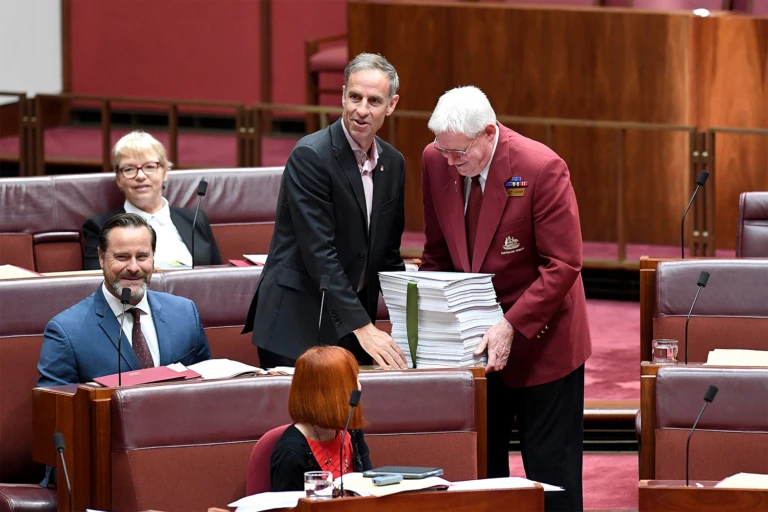
Federal Greens Senators Nick McKim (pictured here) and Peter Whish-Wilson present the petition to the Australian Senate, by which point more than 270,000 people had signed it. Photo: Penny Bradfield
Time didn’t really feel like it was passing. I went with the flow rather than checking my watch (which would not change into the correct time zone, anyway). The large group gathered under the tent. Runners and volunteers were less identifiable as running packs were now all stored in cars and the same general underlying enthusiasm surged from everyone. A very quiet and attentive audience paid close attention to the various speakers from the Bob Brown Foundation and Patagonia welcoming us to the event, and then Bob Brown himself spoke. The vibrancy already gathered was then ignited by the passion with which Bob Brown spoke of takayna / Tarkine, the importance of us being there, the gratitude for the funds already raised and stories of the 10 years’ work protecting the rain forests and Aboriginal lands. He spoke of volunteers living in trees and holding down camps to prevent logging roads and unsustainable forestry; the recent burn area in a coop close by; helicopters dropping a napalm-like substance and igniting what devastation remained of the earlier clear-cut. The exclamation from Dr. Nicole Anderson in the takayna / Tarkine film rang in my head: “How the fuck is this sustainable?!” These warriors standing in harm’s way for the protection of the lands and special wild places stirred up turbulent feelings and a fierce desire to defend this place.
Following the power of Bob Brown, foundation coordinator Jenny Weber introduced race director Lincoln Quilliam, who invited three of us to the stage for a Q&A. Grant, Nicole and I sorted ourselves into a line to answer questions that would help and inspire runners to reach the finish the following day. Of all the answers, my favorite was the way Nicole spoke about the forest. She easily verbalizes what I know all trail runners feel when we move through the land. Whether each has the depth of awareness she does or not, we feel it. From the ferns to the fungi, grasslands to sandy beaches, the pores on our skin absorb spores from the natural air, and that connection is fuel and inspiration for any runner.
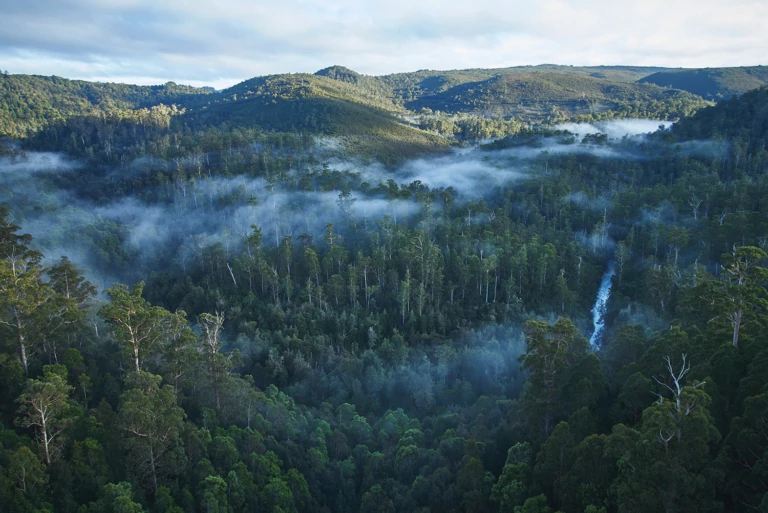
the takayna/Tarkine region, home to one of the last undisturbed tracts of Gondwanan rainforest in the world, and one of the highest concentrations of Aboriginal archaeology in the hemisphere. Photo: Mikey Schaefer
Lincoln then detailed the beauty of the area, potential dangers and unpredicted beach headwinds as a course description. Armed with information and inspiration, the group moved into the hall once again for a Welcome to Country by local Aboriginal Culture Center representative Dewayne Everettsmith. His story of finding his connection to himself at 17 by understanding the history of his people and their relationship with the land will forever stay with me through the song he sang. He’d encouraged us to close our eyes and visualize our own special place and the people we hold dear while listening. The experience was later shared on Facebook.
As I write now, I can see the collective events that built the vibe that encompassed the weekend. Following the peaceful energy that took over the room after Dewayne’s song, we shared the home-cooked, plant-based meal served on the collection of mismatched plates and bowls provided by the hall. We had delicious food prepared by a team of volunteers led by an activist, doctor and a runner named Lisa (she also ran in the 22 km). Countless hours and personal energy poured into the collective feeling of this gathering and created an easy setting for runners and volunteers. I noticed that the typical eagerness of pre-race jitters seemed to have been left at the door; instead, we enjoyed a meal with unfamiliar faces and fast friends.
“There was a blockade. The rest of the runners have been held at the hall by a blockade.” Shannon Bourke, the Patagonia enviro-marketing director, told us. She had driven back to an area with cell service and contacted the race director. “They are figuring out how to pile people in private cars, but locals are trying to stop that too. The race is going to be delayed.”
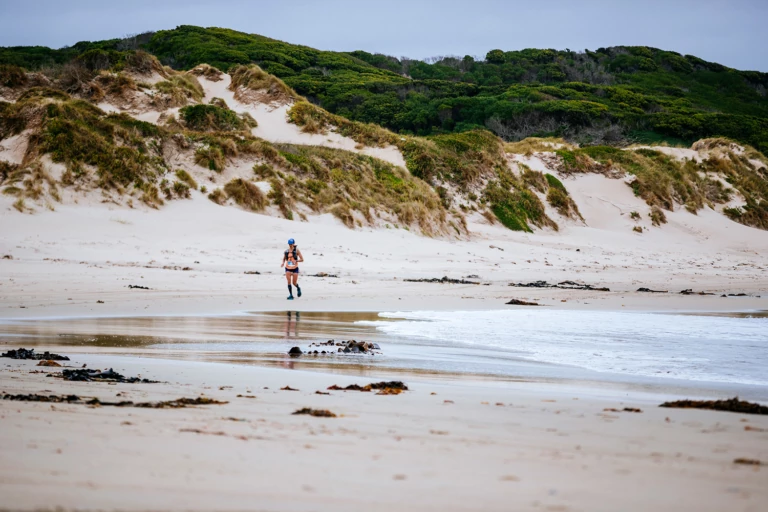
The inaugural takayna/Tarkine Ultra took place with 100 runners traversing either 65km or 22km along the rugged takayna/Tarkine coastline. Photo: Jarrah Lynch
I immediately wished I was there with the runners—not that I would know what to say to speak up—but to just be with them. I wasn’t the only one with this feeling, as we later learned that Bob Brown appeared on the scene to talk with the protesters and better understand their fears about protecting takayna / Tarkine. Some feel threatened that their existence and ability to provide for their families will disappear, and their children will not have the forestry work they have known. It is an old way and the only known way, and change is uncomfortable and scary, though forestry jobs have been declining over the past few years. The police eventually arrived, and the cars and buses were allowed through. The majority of runners arrived in cars, and a group of about 60 started at 7:15 a.m. to a quick “Ready, Set, Go!” Jenny, the Bob Brown Foundation coordinator, pre-empted the announcement by saying, “I’ve never started a race, so I’ll just say ready, set, go.” Less than three seconds later she said, “Ready? Set. Go!” The group laughed, “I guess we are starting!” and we fumbled to hit start on our watches and started running through the tall grasses in the early-morning light— headlamps no longer needed as the sky lit up around us. The remaining runners, having had to wait for the police to break up the blockade, started an hour later with similar enthusiasm. Many had never seen this much of takayna / Tarkine.
Thursday morning before the race, the team of Patagonia staff, Grant and I piled in a car to recce the course, see a bit of the rain forest and check out the Sumac camp, a current Bob Brown Foundation stronghold. Guided by a foundation team member named Eric, we first detoured from the plan to check out the recently burned coop. With only one night of sleep after 40 hours of travel, I wasn’t sure if what I was seeing was a nightmare or reality. The jagged remains of trees were charred, and the earth was still smoldering. I rubbed my eyes before I started asking questions. Unfortunately, I was wide awake and couldn’t believe my eyes. “Why would someone look at this and think this is a good idea?” Grant chimed in, “Yah, can you imagine giving a high five after this?” We all stood there in awe of the destruction and slowly shook our heads not understanding the “why.”
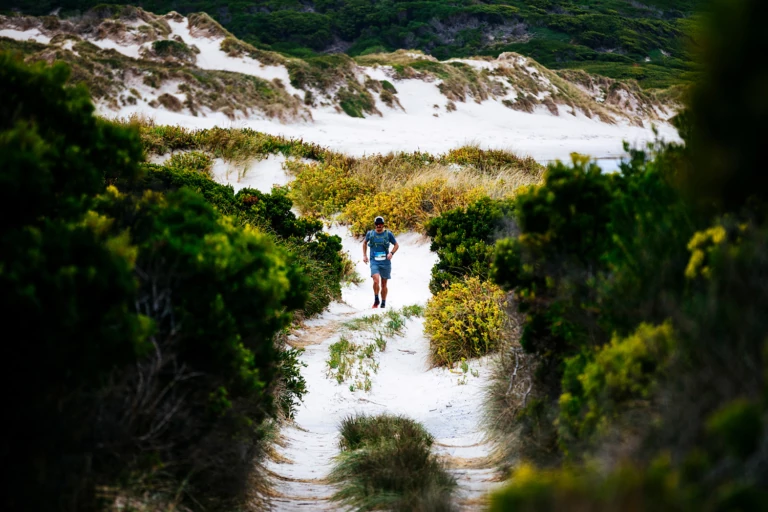
Despite the beginning of the race being disrupted by a few locals blockading the road to the race start, nearly all runners completed the course. Photo: Jarrah Lynch
Eric provided some level of understanding. He spoke of the varying views and the discrepancy from “up top” versus the front lines. Those sending the orders and those doing the deed. The justification as well as not knowing any different. The money motivating the leaders, most of whom had never laid eyes on this beauty, and the fear of unknown and possible change by the forestry workers if the industry disappears. There are some amazing opportunities for employment in takayna / Tarkine, but with the construed, singularly focused desires of those hundreds of miles away, it becomes as dirty and confusing as the smoldering, charred earth beneath my feet.
We headed up to the Sumac camp to see tall, towering old-growth trees. Our entire group took in the freshness, significance and awe of these gentle giants. It absolutely fascinated me that these volunteers put themselves in harm’s way to protect these ancient trees. Their intention is to stop the development of a road into the heart of a developing rain forest that would provide the access to pull out these ancient resources to make wood pulp. The whole scenario blew my mind, from upper “leaders” with such short-sighted thinking to the commitment of these volunteers spending nights and weeks in camp and up in the trees to prevent the local workers from continuing a path of destruction. Amidst the slurry of confusing thoughts, I felt immense gratitude for the opportunity to see and try to understand the conflict and acknowledged that my heart aligned with the trees and these volunteers.
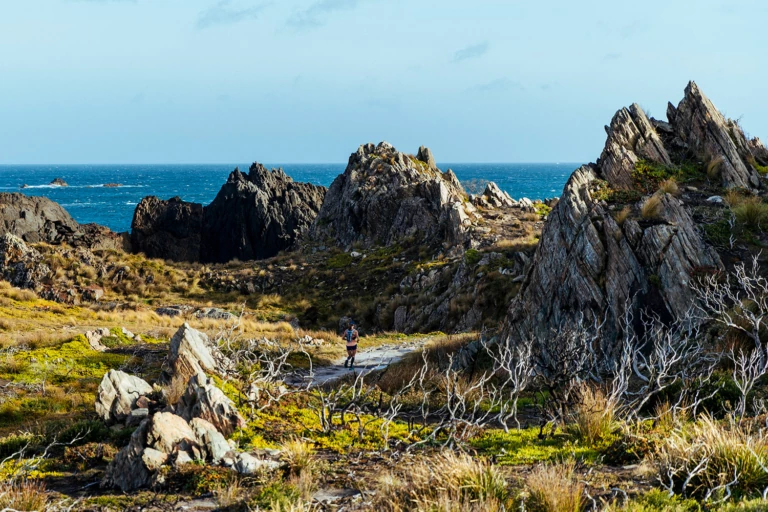
Over $100,000 was raised by runners to support the Bob Brown Foundation. Photo: Jarrah Lynch
I love big trees. I have the forested Chuckanut ridgeline tattooed along my back and left ribcage. Protecting wild spaces, however, was not my initial intention. Being among trees, moving through dense forests on single-track trail and exploring varying landscapes generates an energy and connection to something much greater that provides the “why” to life for me. I know in those wild spaces I can breathe, feel inspired and gain perspective to be able to cope and understand the other rigors and beauties that life holds. On a recent ridgeline training run where we’d climbed above the clouds, a friend said, “I don’t want to go back to reality.” I suggested, “I like to think this is reality. This [running above it all on dirt] is what life really is.”
Tramping through the bush and following pink ribbons that indicated the way, I looked for the colorfully dressed runners dotted along the horizon ahead and behind me. Somewhat unknowingly, these unbalanced running steps through lumping button grass were pounding a connection with takayna / Tarkine into my soul. The challenging off-track section focused my intention on just the next step, and when I did have a chance to look up, the wind touched my face and the view of the plains and the ocean stretched out before me ensuring there was more to come. The spirit of the runners around, as well as the volunteers at every turn, added to my growing love for this corner of Tasmania.
We ran 17 kilometers to the coast through the double-track and off-track to find ourselves full-on into the rugged Tasmanian coast. Amazing waves and rock formations detailed the twists and turns as we ran north for the remaining 45 kilometers to the finish area. While Lincoln had planned and hoped for a favorable tailwind, Mother Nature shifted, and we were instead challenged to run directly into the sand drifts that blasted and abraded our exposed skin. The brim of my trucker cap quickly became the most valuable piece of gear I wore or carried that day. My sticky, sweaty skin provided the perfect adhesive for the sand to coat exposed areas. The wind was so loud I couldn’t chat with the man shuffling alongside me in the final kilometers. Instead, we encouraged each other along with sideways glances and hand gestures until we had the brief protection of the hills to communicate a few words when the course weaved inland the slightest bit to avoid running straight into the ocean. I thought back to the plains from earlier that morning, the trees from the day before and the extreme differences in vegetation all connectable by my two feet moving forward relentlessly. Into the storms and pushing forward, the story of a long-distance runner is not unlike the challenge of the work nonprofit organizations like the Bob Brown Foundation face. We both have to take it in stride, be comfortable with the challenges and ever more, keep moving forward.
Just like the evening before the race, all runners and volunteers were served a filling, home-cooked, plant-based meal with tea and dessert at the hall. The gathering maintained a similar vibe, only this time runners were a little more identifiable for the wind- and sun-burnt cheeks and the telltale stutter in their step—stiffened legs from the effort of the day. The organizations, namely Patagonia and Bob Brown Foundation, later set the stage with artistic trophies and boxes of outdoor gear for Lincoln to announce the awards. His handwritten results on crumpled papers pulled from his hiking-pants pockets denoted the impressive times considering the conditions. Individuals placing in the 22 km and 65 km races humbly accepted their awards and posed for photos to document this inaugural event. With just as much interest and enthusiasm, the fundraising awards were also announced. I felt a deeper smile than I had all day when Kate Hanson, the lovely woman I met in line the day before, accepted an award for raising over $7,000. She was one of the last finishers of the race, and her enthusiasm overrode any soreness she might have felt as she hopped up to receive her award and hug each of the race directors and foundation staff. As a collective, we raised over $100,000, the foundation’s single-highest-earning fundraising endeavor. That too added to the depth of my happiness; I was filled with joy for the effort and the connection to the land.
As present as I felt through the experience, something more powerful struck me as the plane pulled wheels up from the Burnie airport. This event and the wild of Tasmania tore into my heart, embedded in my soul and ignited a deep emotion for people and places. The connection promised in the Welcome to Country bore deep. After reading through the continued posts on the takayna ultramarathon Facebook page, I know I am not the only one who carries this love and hope for takayna / Tarkine as well as the enthusiasm to identify and work for this place. This event symbolized the connection to the importance of wild spaces, wherever they are in the world, as well as the people who are passionate about protecting them. If you get out in it to know it, then you’ll love it. If you love it, you’ll protect it.
takayna
takayna / Tarkine in northwestern Tasmania is home to one of the last undisturbed tracts of ancient rainforest in the world, and one of the highest concentrations of Aboriginal archaeology in the southern hemisphere. Yet this place is currently threatened by logging and mining. takayna, weaves together the narratives of activists, a trail running doctor and the Aboriginal community to unpack the complexities of modern conservation and challenge us to consider the importance of our last truly wild places.
